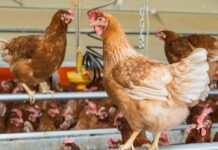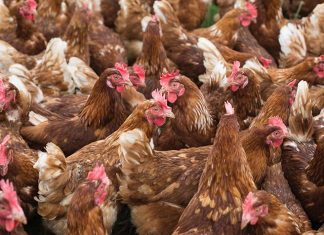
Analyses dealing with the dynamics and patterns of the global egg industry mostly ignore the least developed countries (LLDC). In this paper, their role in the global egg industry will be documented.
Analyses dealing with the dynamics and patterns of the global egg industry mostly focus on the leading countries. This is also the case for many papers of this author. When preparing a detailed analysis dealing with the role of the threshold countries in the global egg industry, I realized that the least developed countries (LLDC)[1] were ignored. That was the reason for dealing with this group of countries in more detail.
Wide gap between their share in the global population and in egg production
In 2018, 31 of the 46 LLDC were located in Africa, nine in Asia and 5 in Oceania. They had a population of 1 billion inhabitants, a share of 13.2% in the global population. The countries had a laying hen inventory of 480.4 mill. birds and they produced 1.9 mill. t of eggs (Table 1). The imbalance between population and egg production is obvious.

When dealing with the situation at continent level, the wide difference between their share in population, laying hen inventory and egg production becomes obvious (Table 2). The highest share in the population reached the LLDC in Africa, followed Asia, Oceania and the Americas. This ranking was the same in their share in the laying hen inventories and in egg production. In Africa, the LLDC contributed 30.2% to the laying hen inventory and 21.1% to egg production. In Asia, too, their share in egg production was much lower than in the continent’s population. The gap was even wider in Oceania and Haiti, the only LLDC in the Americas.

A comparison of the share in the laying hen inventories an in egg production reveals the low efficiency in laying hen husbandry in the LLDC in relation to the industrialised and threshold countries. Local breeds, less quality feed and the lack of veterinary services are the main reasons for the low efficiency. In many countries small backyard flocks are dominating. In Asia, these small farms are a continuous threat regarding the introduction and dissemination of the Avian Influenza virus. It assume, however, that the available inventory and production data is too low and is not necessarily an indicator of an insufficient availability of eggs for the rural population. In many small farms, laying hens are double purpose hens as they are kept for egg production and as a meat source.
High regional concentration in laying hen husbandry
One has to go down to the country level to get an impression of the uneven distribution of the laying hen inventories. Between 2008 and 2018, the laying hen inventories of the LLDC increased by 157.8 mill. birds or 48.9% (Table 3). To this growth, the ten leading countries contributed 139.8 mill. hens. The highest absolute increase showed Bangladesh with 81.5 mill. birds (+70.3%) and Myanmar with 35.9 mill (+73.6%). High absolute growth rates were also to be found in Nepal (+7.3 mill.) and Mozambique (+6.1 mill.). Bangladesh and Myanmar together contributed 84.0% to the overall growth of the laying hen inventories in the LLDC in the analysed decade.

The high degree of the regional concentration is worth noting. It increased from 77.2% to 81.0%. The two leading countries, Bangladesh and Myanmar were in a dominating position. Their contribution to the inventories of the LLDC grew from 51.1% to 58.7%. The following paragraph will show that in both countries egg production increased faster than the inventories, an indicator of the growing efficiency of the egg industry.
High regional concentration also in egg production
Table 4 lists the ten leading LLDC in egg production in 2008 and 2018. In egg production, the regional concentration also increased. A comparison of the composition and ranking of the countries reveals several notable patterns and changes. Myanmar ranked in first place before Bangladesh despite the much lower number of laying hens, followed by Tanzania and Nepal. These two countries could also increase their production volume considerably. While Myanmar’s share in the total production volume of the LLDC increased by only 5.7%, Bangladesh gained 8.8%. In both countries, the efficiency of egg production grew considerably.

Between 2008 and 2018, egg production in the LLDC increased by 878,000 t or 77.0%.To this growth, the two leading countries contributed 626,300 t or 74.8%. In both countries, the absolute increase was very similar, but the laying hen inventory in Myanmar grew by only 35.9 mill. hens compared to 81.5 mill. in Bangladesh. Obviously, the efficiency of egg production in Myanmar was higher than in Bangladesh. Capital investments of Thailand’s CP group and the use of hybrid hens were the main steering factors behind the difference in the dynamics. The regional concentration in egg production was similar to that in the laying hen inventories. In 2008, the two leading countries shared 41.3% in the overall egg production of the LLDC; in 2018, it was already 55.8%, a result of the remarkable dynamics in Myanmar, Bangladesh and Nepal.
Hens per inhabitant – a measure for the self-sufficiency with eggs?
Hardly any data on the per capita consumption of eggs is available for the LLDC, so it is almost impossible to calculate the self-sufficiency rate. One can try to estimate it by calculating the number of laying hens per inhabitant (Table 5). It has to be considered, however, that also hardly any data is published for the laying rates of the hens in these countries. Assuming that in Tanzania a laying hen in a backyard flock would lay 120 eggs per year would mean that an average of 35 eggs would be available per person and year. The fast increase of egg production in Myanmar and Bangladesh (see Table 4) is a result of the high number of hens per inhabitant. A comparison at continent level reveals that Africa with only 0.4 hens per person ranks far behind Asia and Europe. This documents the problem of supplying the population in Africa with valuable animal proteins.

A comparison of the data for Germany and the Netherlands shows the extremely high self-sufficiency of the Netherlands and explains why they are the leading egg exporting country worldwide. Even with a laying rate of 290 eggs per hen, Germany had to import large amounts of eggs because of a per capita consumption of 235 eggs/year. In Europe as a whole, the egg industry produces a surplus and permits exports. At the global scale, the relation between production and consumption seems to be balanced. A detailed analysis at country level would show that the self-sufficiency rate differs considerably. The gap between the Netherlands and the Central African Republic, to mention two extreme positions, is incredibly wide.
Data source and additional literature
FAO database: www.faostat.org.
Windhorst, H.-W.: Emerging Markets Countries. Dynamics and Patterns of the Egg Industry. (= WING – Beiträge zur Geflügelwirtschaft 23). Vechta 2020. (https://wing.tiho-hannover.de/pdf_files/wing-beitraege-heft-23_860_1.pdf).
[1] A list of the LLDC is available from:A list of the LLDC is available from: http://www.fao.org/faostat/en/#data/QL.

















